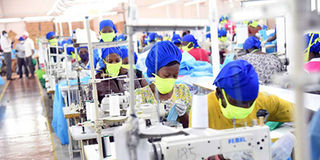Covid-19 fails to dampen manufacturing growth

Face masks and other personal protective equipment are manufactured at Shona EPZ Limited in Athi River on April 14, 2020 to assist in the fight against coronavirus.
The Covid-19 pandemic had a mixed impact on the manufacturing sector last year, with half of the sector recording growth while the other half suffered huge losses.
According to the Economic Survey 2021, while sub-sectors dealing in leather, beverages, motor vehicle, rubber and dairy products contracted, mainly due to their nature of operations that forces them to rely on different inputs for production, others such as pharmaceutical products, sugar, non-metallic products, basic metals and processed foods grew.
Overall, the sector contracted by 0.1 percent, compared to a growth of 2.5 percent in 2019, closing the year with a share to GDP of 7.6 percent.
“Sub-sectors that registered major growth volume of output were sugar, other non-metallic mineral products such as cement, food products such as tea, chemical and chemical products and pharmaceutical products. Sugar production recovered from 10.2 percent drop in 2019 to a significant growth of 36.9 percent in 2020. The quantity of sugar produced rose from 440,900 tonnes in 2019 to 603,800 tonnes in 2020,” the report stated.
The 5 percent expansion of the pharmaceutical products last year (compared to a growth of 1.6 percent in 2019) can be linked to the Covid-19 pandemic, which had the impact of tilting reliance on health facilities and products in the country. The report noted that production of tablets, capsules and syrups increased by 8.2, 1.2 and 1.1 percent respectively in 2020.
Further, containment measures and the resultant effect of people staying at home and relying on home deliveries had a positive effect on production of rubber and plastic products, which grew by 1.9 percent.
“The growth was due to increased production of articles of conveyance of packing goods -- self-adhesive plates, sheets, film, foil, tableware and kitchenware by 11.5, 0.8 and 2.2 percent respectively,” the report showed.
Closing the line of sub-sectors that grew in the midst of the health and economic pandemic was cement production, which increased by 21.3 percent to 7,473,600 tonnes in 2020, due to expansions by cement producers.
But the report noted that cement exports to Tanzania and Uganda declined by 36.6 percent, even as exports to all other countries rose to 108,500 tonnes, from 42,000 tonnes in 2019.
On the other hand, leather, beverages, motor vehicle, trailers and semi-trailers, rubber and dairy products sub-sectors were taking a hit as the pandemic ravaged their operations, causing huge job cuts and low production.
For instance, the beverages and tobacco sub-sector contracted by 13.4 percent from a growth of 6.1 percent in 2019, following reduced production of malt, spirits and soft drinks by 29.5, 22 and 6.3 percent respectively.
“Production of soft drinks (sodas) decreased to 550.6 million litres in 2020 from 592.5 million litres in 2019. However, production of tobacco products increased by 4.9 percent in 2020,” the Economic Survey report stated.
The contraction in the manufacturing sector had an adverse impact on employment and credit to the sector, the report showing that financial institutions’ credit to the sector declined from Sh1.7 billion in 2019 to Sh1.1 billion in 2020.
The number of persons in formal manufacturing sector decreased by 10.3 percent from 353,300 in 2019 to 316,900 in 2020, while the number of local employees in EPZ enterprises dropped by 7.7 percent to 55,736.
During the year, the report noted, compensation of employees in the sector reduced by 1.3 percent to Sh215.6 billion.
“Total sales in Export Processing Zone (EPZ) enterprises increased by 4.3 percent to Sh80.5 billion in 2020 while the value of domestic sales contracted from Sh8.6 billion in 2019 to Sh6.7 billion in 2020. Exports from EPZ increased by 7.6 percent to Sh73.8 billion whereas imports enterprises contracted by 7.5 percent to Sh36.8 billion in the same period,” the report stated.
But besides all this, the sector’s value of output increased by 2.8 percent to Sh2.4 trillion, with intermediate consumption increasing by 3.6 percent to Sh1.6 trillion in 2020.





